Assessing the Long-Term Performance of Adhesive Joints in Space Structures during Interplanetary Exploration
Abstract
1. Introduction
2. Materials and Methods
2.1. Materials
2.2. Methods
2.3. Sample Preparation
2.4. Space Environment Exposure
3. Results and Discussion
3.1. Effect Space Environment on Adhesive Intrinsic Properties
3.2. Impact of Space Conditions on Adhesion Properties
4. Conclusions
Author Contributions
Funding
Institutional Review Board Statement
Informed Consent Statement
Data Availability Statement
Acknowledgments
Conflicts of Interest
References
- Braunand, R.D.; Manning, R.M. Mars Exploration Entry, Descent and Landing Challenges. In Proceedings of the 2006 IEEE Aerospace Conference, Big Sky, MT, USA, 4–11 March 2006; Volume 1. [Google Scholar]
- Martin, A.A. Model Predictive Control for Ascent Load Management of a Reusable Launch Vehicle. Ph.D. Thesis, Massachusetts Institute of Technology, Cambridge, MA, USA, 2002. [Google Scholar]
- Chen, J.; Ding, N.; Li, Z.; Wang, W. Organic polymer materials in the space environment. Prog. Aerosp. Sci. 2016, 83, 37–56. [Google Scholar] [CrossRef]
- Justiz, C.R.; Sega, R.M.; Dalton, C.; Ignatiev, A. DSMC and bgk-based calculations for return flux contamination of an outgassing spacecraft. J. Thermophys. Heat Transf. 1994, 8, 802–803. [Google Scholar] [CrossRef]
- Laikhtman, A.; Verker, R.; Gouzman, I.; Noter, Y.; Grossman, E. Outgassing Effects of a Kapton Acrylic Adhesive Tape; Technical Report; European Space Agency Special Publication ESA SP Issue 616; European Space Agency: Paris, France, 2006. [Google Scholar]
- Zimmermann, J.; Sadeghi, M.Z.; Schroeder, K.U. The effect of γ-radiation on the mechanical properties of structural adhesive. Int. J. Adhes. Adhes. 2019, 93, 9. [Google Scholar] [CrossRef]
- Dagras, S.; Eck, J.; Tonon, C.; Lavielle, D. Adhesives in space environment. In Handbook of Adhesion Technology; Springer: Cham, Switzerland, 2018; Volume 5. [Google Scholar]
- Silverman, E.M. Space Environmental Effects on Spacecraft: Leo Materials Selection Guide; Nasa Contractor Report 4661; NASA Langley Research Center: Hampton, VA, USA, 1995. [Google Scholar]
- ECSS-Q-ST-70-04C; Thermal Testing for the Evaluation of Space Materials, Processes, Mechanical Parts and Assemblies. ESA-ESTEC: Noordwijk, The Netherlands, 2008.
- Stevenson, R.; Chisabas, S.; Loureiro, G.; De Oliveira Lino, C.; Paola, J.; Zabala, O.; Fernando, D.; Salamanca, C. Development of a thermal-vacuum chamber for testing in small satellites. In Proceedings of the 47th International Conference on Environmental Systems, Charleston, SC, USA, 16–20 July 2017. [Google Scholar]
- Teixeira de Freitas, S.; Banea, M.D.; Budhe, S.; de Barros, S. Interface adhesion assessment of composite-to-metal bonded joints under salt spray conditions using peel tests. Compos. Struct. 2017, 164, 68–75. [Google Scholar] [CrossRef]
- Teixeira de Freitas, S.; Zarouchas, D.; Poulis, J.A. The use of acoustic emission and composite peel tests to detect weak adhesion in composite structures. J. Adhes. 2018, 94, 743–766. [Google Scholar] [CrossRef]
- Lee-Sullivan, P.; Dykeman, D. Test method guidelines for performing storage modulus measurements using the TA instruments DMA 2980 three-point bend mode 1 amplitude effects. Polym. Test. 2000, 19, 155–164. [Google Scholar] [CrossRef]
- Teixeira de Freitas, S.; Sinke, J. Adhesion properties of bonded composite-to-aluminium joints using peel tests. J. Adhes. 2014, 90, 511–525. [Google Scholar] [CrossRef]
- Benzarti, K.; Chataigner, S.; Quiertant, M.; Marty, C.; Aubagnac, C. Accelerated ageing behaviour of the adhesive bond between concrete specimens and CFRP overlays. Constr. Build. Mater. 2011, 25, 523–538. [Google Scholar] [CrossRef]
- Teixeira de Freitas, S.; Sinke, J. Test method to assess interface adhesion in composite bonding. Appl. Adhes. Sci. 2015, 3, 9. [Google Scholar] [CrossRef]
- Arouche, M.M.; Budhe, S.; Banea, M.D.; Teixeira de Freitas, S.; de Barros, S. Interlaminar adhesion assessment of carbon-epoxy laminates under salt water ageing using peel tests. Proc. Inst. Mech. Eng. Part L J. Mater. Des. Appl. 2019, 233, 1555–1563. [Google Scholar] [CrossRef]
- Correia, S.; Anes, V.; Reis, L. Effect of surface treatment on adhesively bonded aluminium-aluminium joints regarding aeronautical structures. Eng. Fail. Anal. 2018, 84, 34–45. [Google Scholar] [CrossRef]
- Srinivasan, D.V.; Aggarwal, A.; Idapalapati, S. Temperature-dependent peel performance of adhesively rebonded hybrid joints. Int. J. Adhes. Adhes. 2020, 97, 102474. [Google Scholar] [CrossRef]
- Williamson, J.R.; Semprimoschnig, C.; Simon-Boutemen, P.; Levan, L.; Van Eesbeek, M. Use of model free kinetic lifetime values to evaluate mechanical performance of a high temperature polyimide composite. In Proceedings of the 11th ISME 2009, Aix-en-Provence, France, 5–18 September 2009. [Google Scholar]
- ECSS-E-HB-32-21A; Adhesive Bonding Handbook. European Cooperation for Space Standardization: Noordwijk, The Netherlands, 2011.
- ASTM D638; Standard Test Method for Tensile Properties of Plastics. ASTM International: West Conshohocken, PA, USA, 2014.
- ASTM D7028; Standard Test Method for Glass Transition Temperature of Polymer Matrix Composites by Dynamic Mechanical Analysis. ASTM International: West Conshohocken, PA, USA, 2015.
- ASTM E2254; Standard Test Method for Storage Modulus Calibration of Dynamic Mechanical Analyzers. ASTM International: West Conshohocken, PA, USA, 2018.
- ASTM E2425; Standard Test Method for Loss Modulus Conformance of Dynamic Mechanical Analyzers. ASTM International: West Conshohocken, PA, USA, 2016.
- ASTM D3167; Standard Test Method for Floating Roller Peel Resistance of Adhesives. ASTM International: West Conshohocken, PA, USA, 2017.
- ASTM D5528; Standard Test Method for Mode 1 Interlaminar Fracture Toughness of Unidirectional Fiber-Reinforced Polymer Matrix Composites. ASTM International: West Conshohocken, PA, USA, 2013.
- ECSS-Q-ST-70-16C; Space Product Assurance Adhesive Bonding for Spacecraft and Launcher Applications. ESA-ESTEC Requirements and Standards Section: Noordwijk, The Netherlands, 2020.
- Huang, G.; Ni, Z.; Chen, G.; Zhao, Y. The influence of irradiation and accelerated aging on the mechanical and tribological properties of the graphene oxide/ultra-high-molecular-weight polyethylene nanocomposites. Int. J. Polym. Sci. 2016, 2016, 2618560. [Google Scholar] [CrossRef]
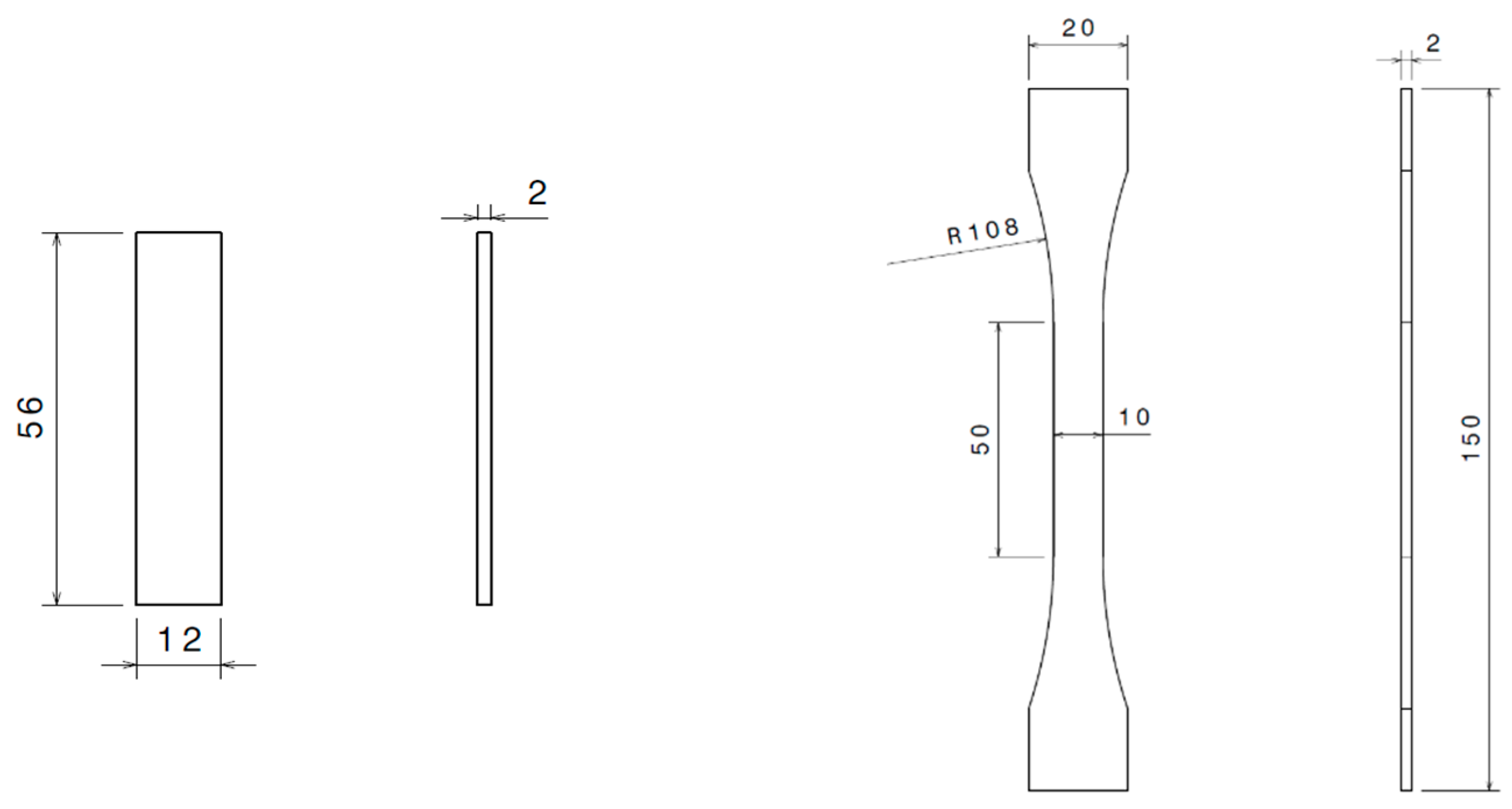


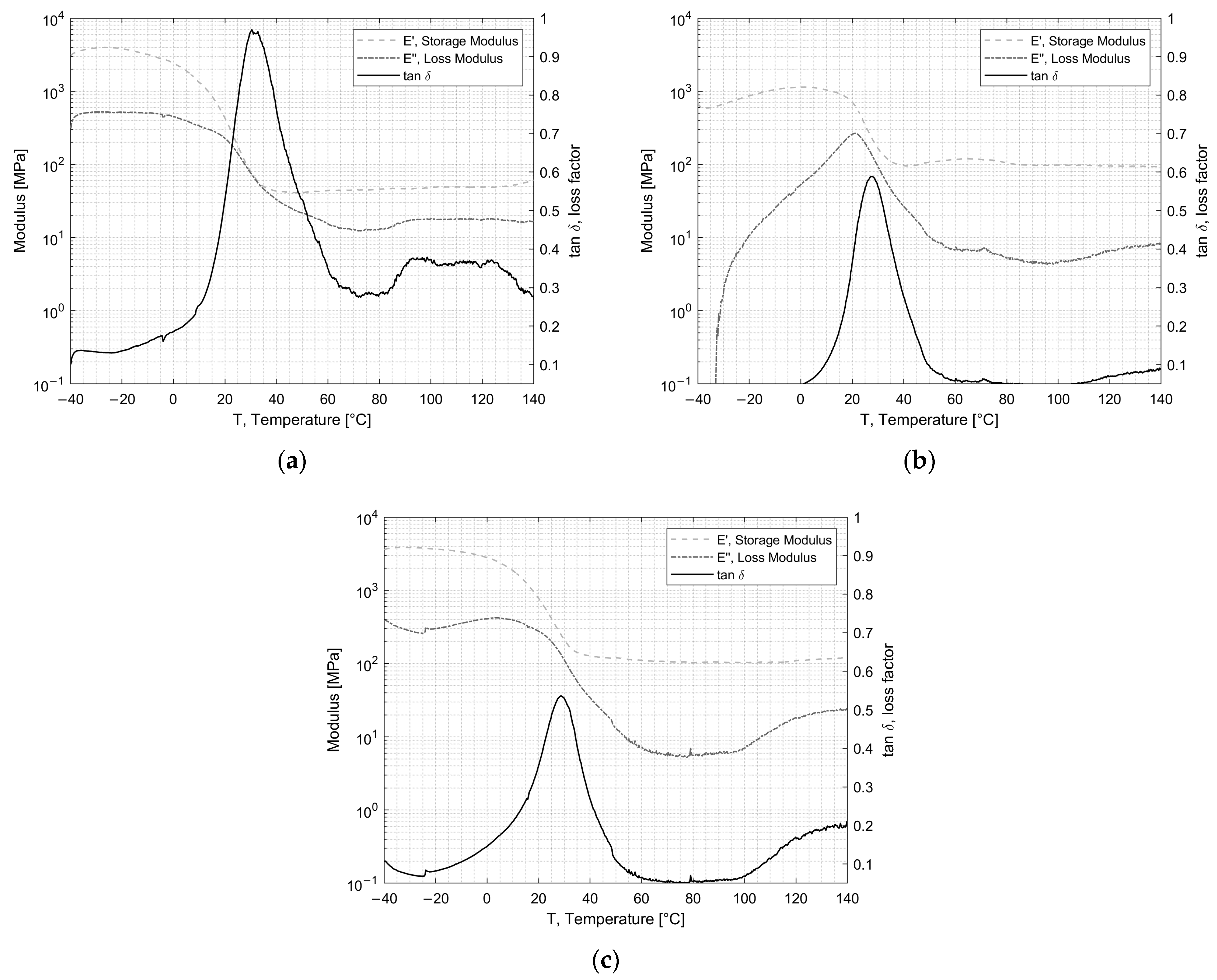
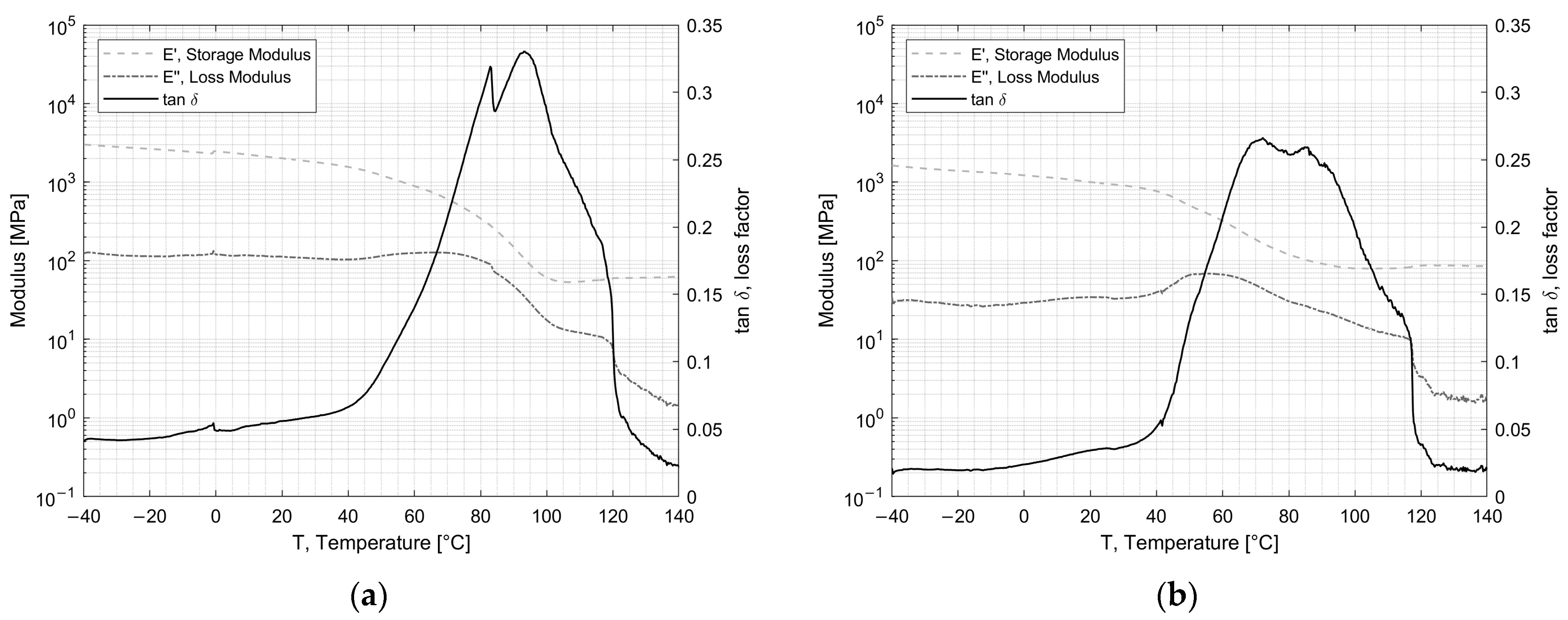
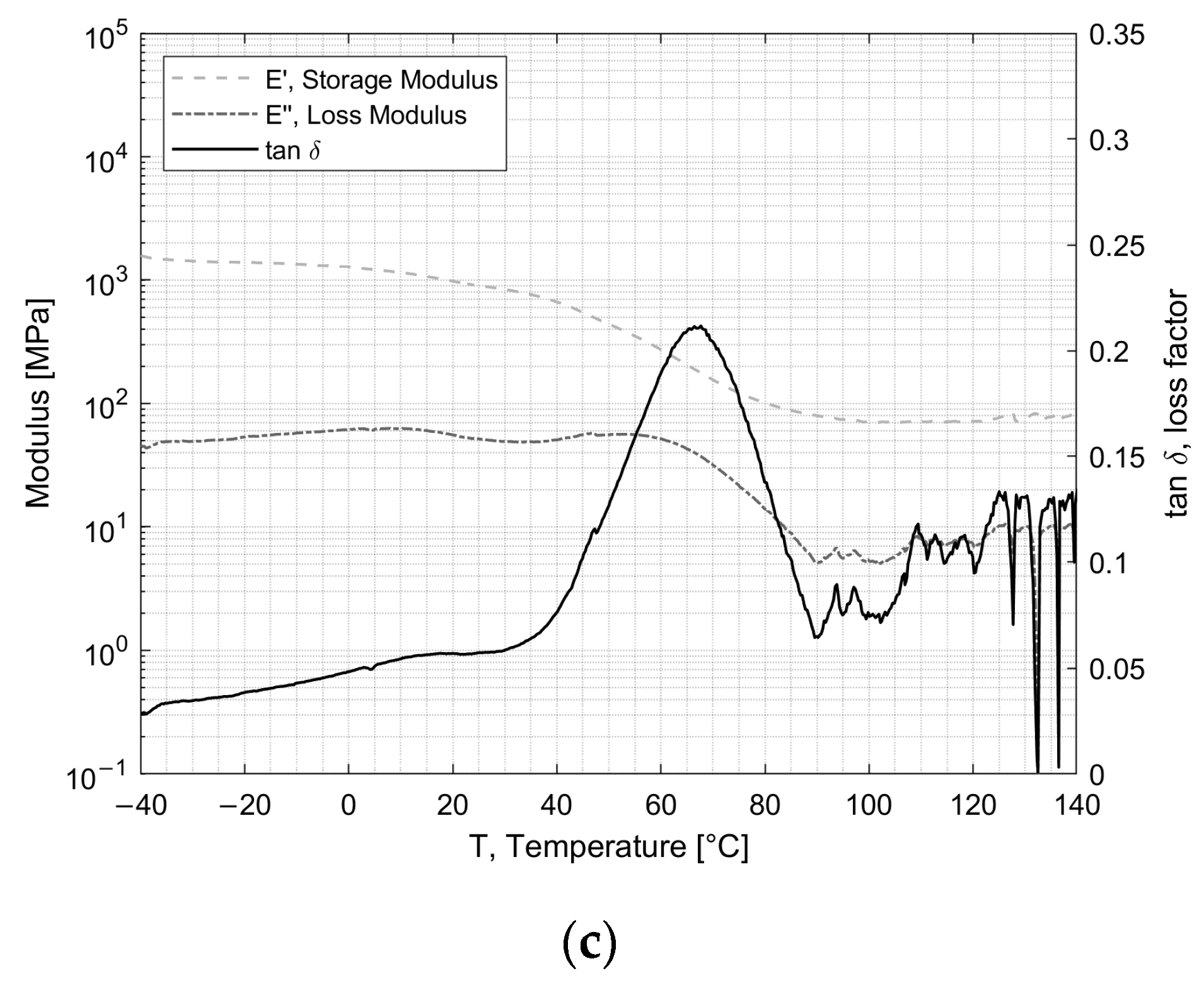
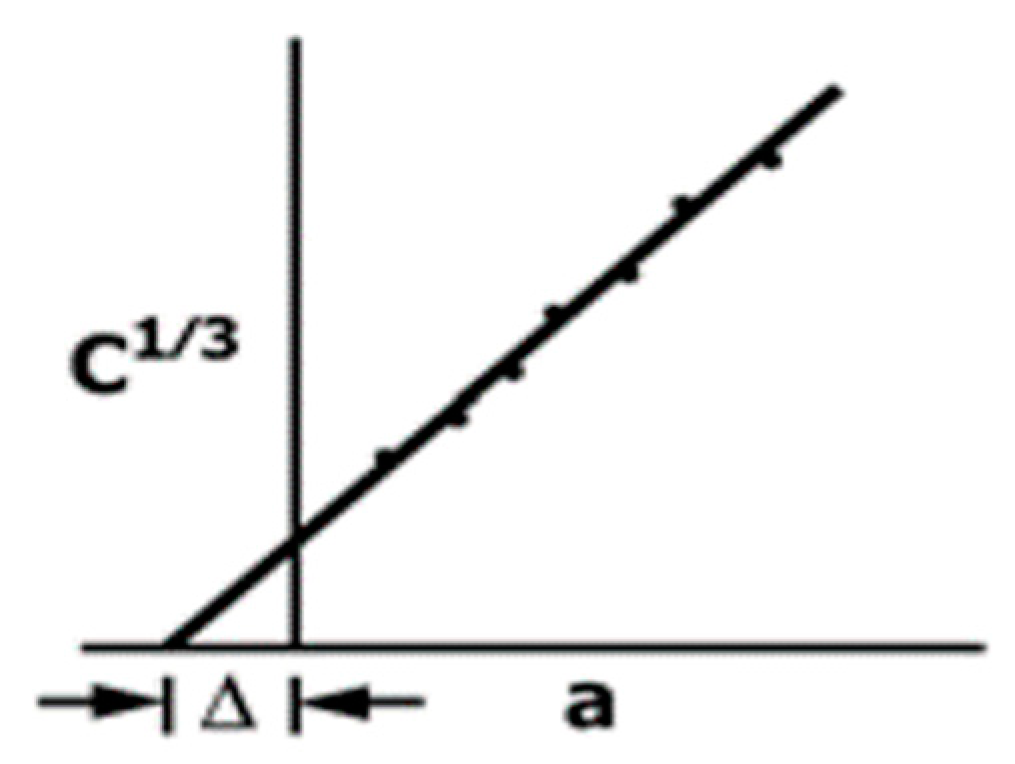
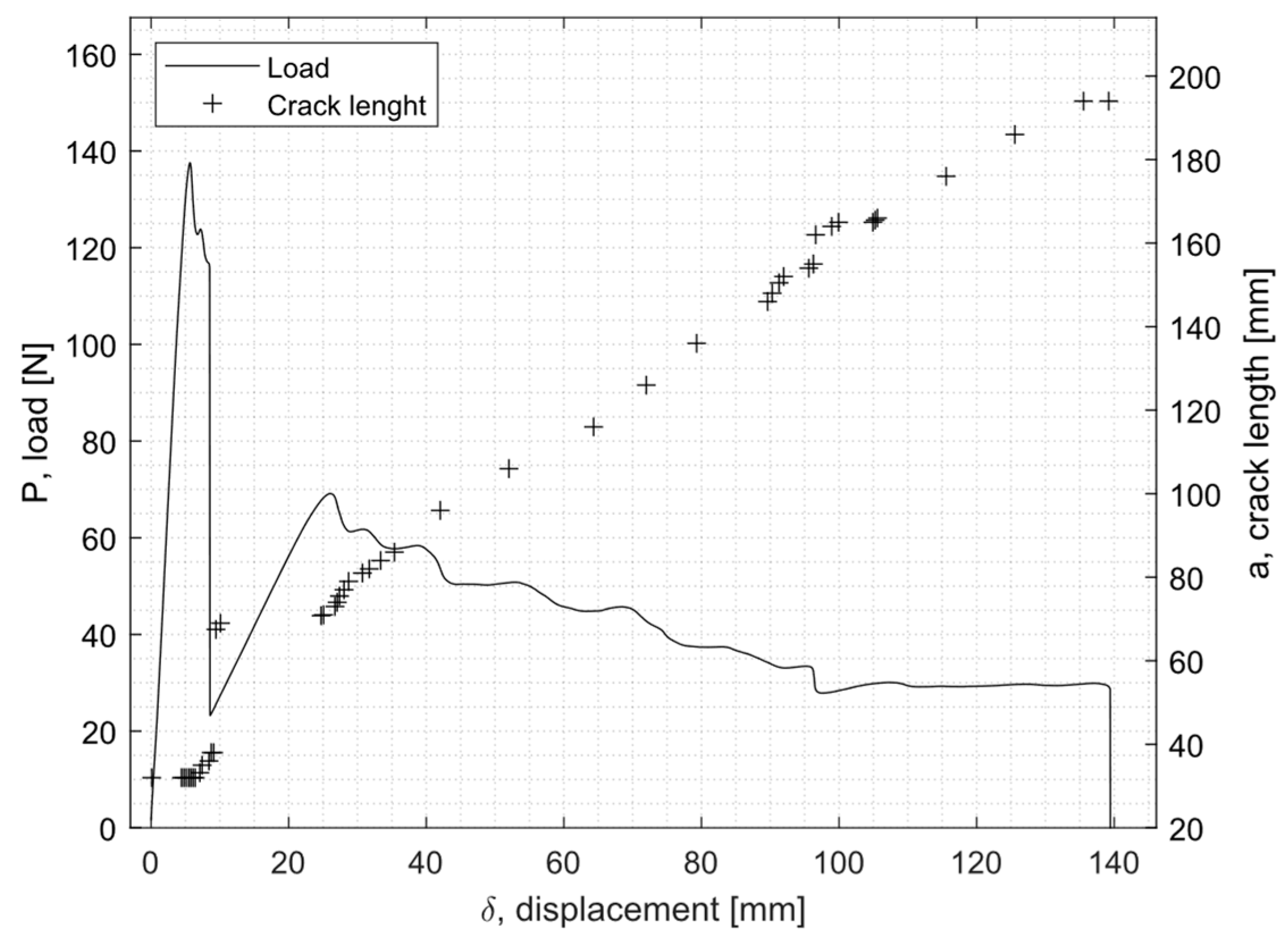

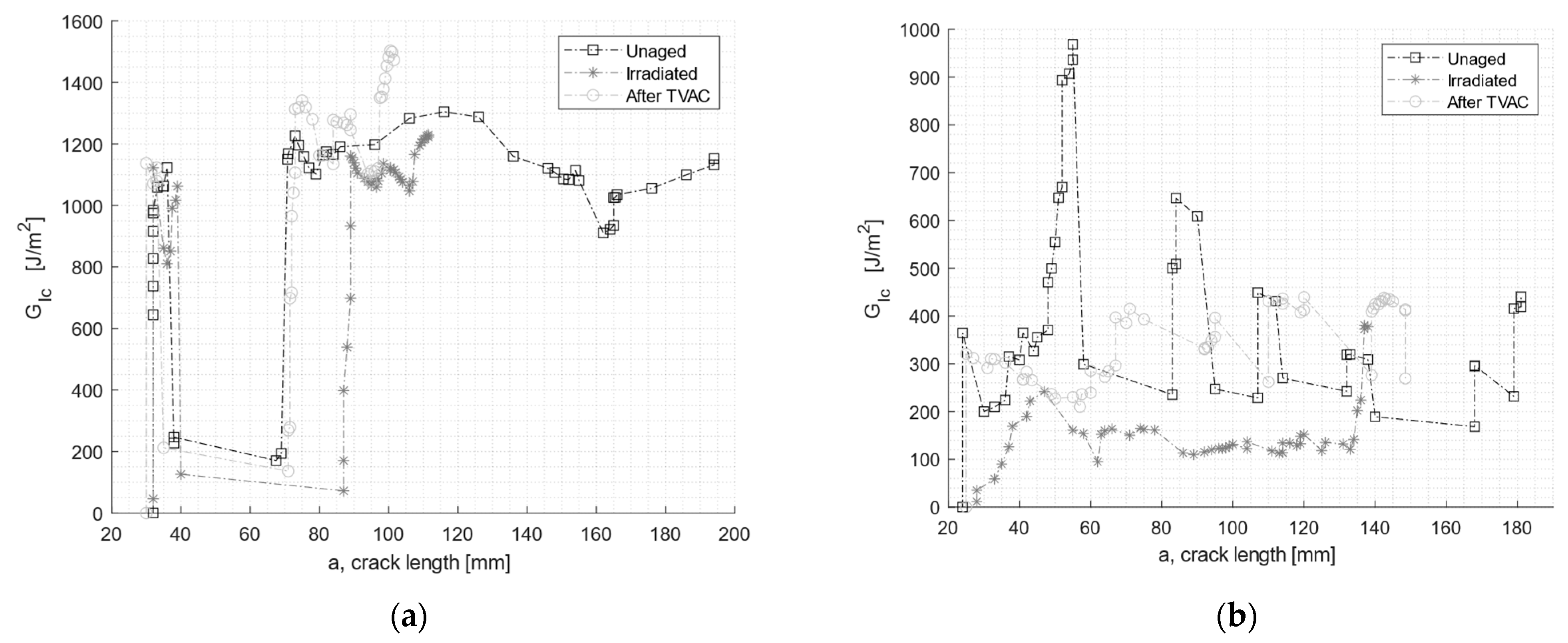
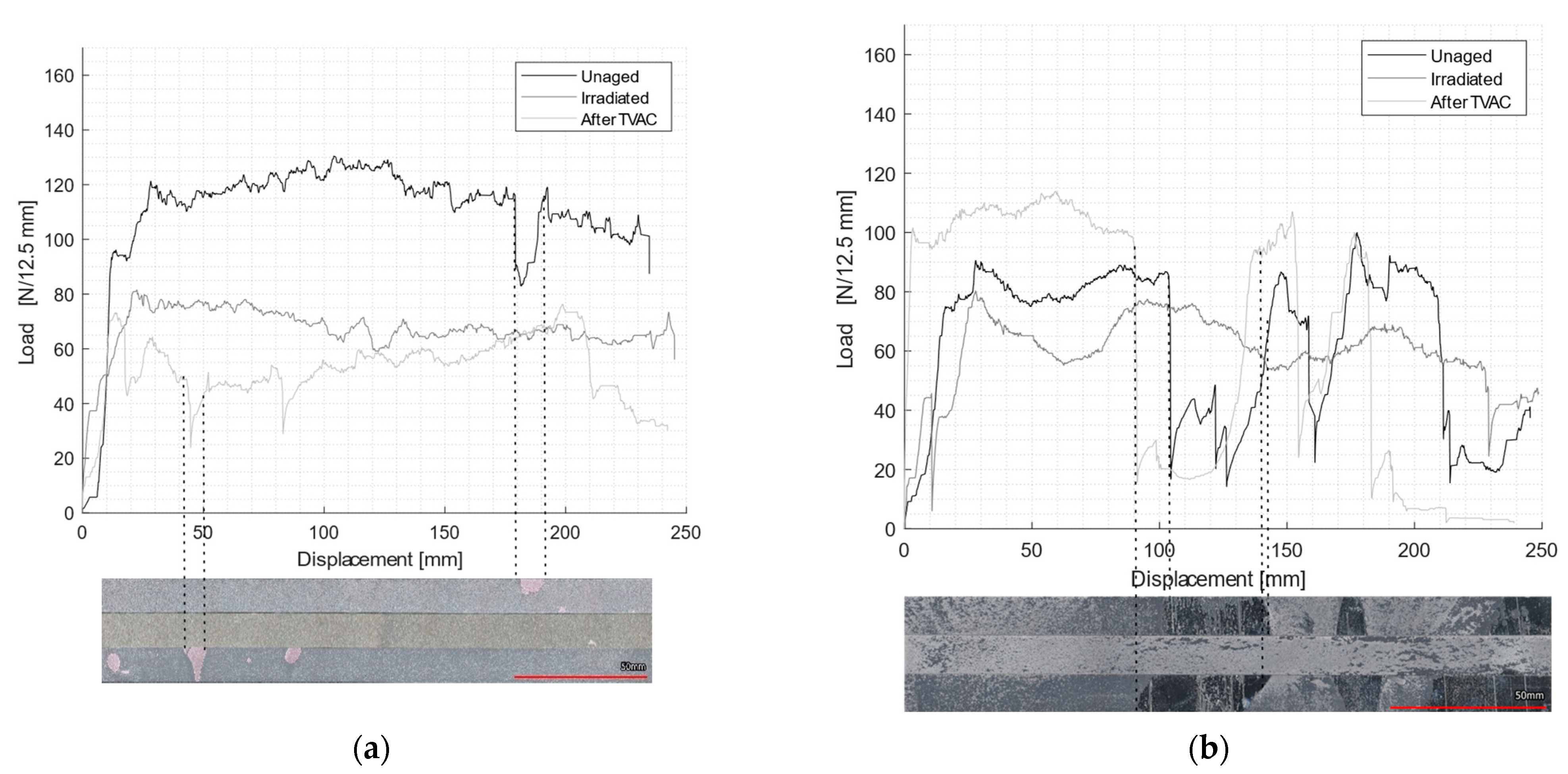

| Adhesive | Curing Temperature (°C) | Curing Time (min) | Part A/B (Weight Ratio) |
|---|---|---|---|
| EC 2216 | 66 | 120 | 7/5 |
| EA 9323-2 | 65 | 120 | 1/2 |
| Aging | Scotch-Weld™ EC-2216 | Scotch-Weld™ EC-9323-2 | ||||
|---|---|---|---|---|---|---|
| E (MPA) | σmax (MPA) | εmax | E (MPA) | σmax (MPA) | εmax | |
| Unaged | 242 ± 48 | 19 ± 1.3 | 0.74 ± 0.08 | 2197 ± 703 | 20 ± 4.2 | 0.027 ± 0.007 |
| Irradiated | 123 ± 49 | 15 ± 3.3 | 0.53 ± 0.29 | 1026 ± 267 | 17 ± 2.2 | 0.026 ± 0.008 |
| After TVAC | 606 ± 130 | 28 ± 1.5 | 0.61 ± 0.07 | 1042 ± 198 | 18 ± 1.0 | 0.033 ± 0.008 |
| Aging | Tg from Max Tan δ (°C) | |
|---|---|---|
| Scotch-Weld™ EC-2216 | Scotch-Weld™ EC-9323-2 | |
| Unaged | 28 ± 1.1 | 91 ± 7.4 |
| Irradiated | 30 ± 2.2 | 72 ± 3.6 |
| After TVAC | 30 ± 1.8 | 68 ± 7.8 |
| Aging | Scotch-Weld™ EC-2216 | Scotch-Weld™ EC-9323-2 | ||||
|---|---|---|---|---|---|---|
| Failure Mode | Failure Mode | |||||
| (on CF) | CF (%) | AF (%) | (on CF) | CF (%) | AF (%) | |
| Unaged | 1203 ± 52 | 61 ± 15 | 39 ± 15 | 280 ± 100 | 10 ± 10 | 90 ± 11 |
| Irradiated | 1142 ± 79 | 41 ± 23 | 59 ± 23 | 142 ± 11 | 0.5 ± 1 | 100 ± 1 |
| After TVAC | 1348 ± 130 | 31 ± 13 | 69 ± 13 | 302 ± 33 | 0 ± 0 | 100 ± 0 |
| Aging | Scotch-Weld™ EC-2216 | Scotch-Weld™ EC-9323-2 | ||||||
|---|---|---|---|---|---|---|---|---|
| Fave (N/12.5 mm) | Failure Mode | Fave (N/12.5 mm) | Failure Mode | |||||
| CF (%) | AF (%) | MD (%) | CF (%) | AF (%) | MD (%) | |||
| Unaged | 111 ± 6.4 | 97 ± 2.2 | 0.8 ± 1.1 | 2 ± 1.3 | 87 ± 8 | 54 ± 27.2 | 0 ± 0 | 46 ± 27.2 |
| Irradiated | 68 ± 3.5 | 93 ± 6.1 | 6 ± 6.5 | 0.4 ± 0.8 | 62 ± 5.5 | 63 ± 23.9 | 2.2 ± 8 | 35 ± 26.2 |
| After TVAC | 53 ± 6 | 63 ± 17.7 | 30 ± 20 | 7 ± 1.4 | 105 ± 5 | 50 ± 7.3 | 0 ± 0 | 49 ± 7.3 |
Disclaimer/Publisher’s Note: The statements, opinions and data contained in all publications are solely those of the individual author(s) and contributor(s) and not of MDPI and/or the editor(s). MDPI and/or the editor(s) disclaim responsibility for any injury to people or property resulting from any ideas, methods, instructions or products referred to in the content. |
© 2023 by the authors. Licensee MDPI, Basel, Switzerland. This article is an open access article distributed under the terms and conditions of the Creative Commons Attribution (CC BY) license (https://creativecommons.org/licenses/by/4.0/).
Share and Cite
Charpentier, G.; Lafont, U.; Teixeira de Freitas, S. Assessing the Long-Term Performance of Adhesive Joints in Space Structures during Interplanetary Exploration. Materials 2023, 16, 4978. https://doi.org/10.3390/ma16144978
Charpentier G, Lafont U, Teixeira de Freitas S. Assessing the Long-Term Performance of Adhesive Joints in Space Structures during Interplanetary Exploration. Materials. 2023; 16(14):4978. https://doi.org/10.3390/ma16144978
Chicago/Turabian StyleCharpentier, Gabin, Ugo Lafont, and Sofia Teixeira de Freitas. 2023. "Assessing the Long-Term Performance of Adhesive Joints in Space Structures during Interplanetary Exploration" Materials 16, no. 14: 4978. https://doi.org/10.3390/ma16144978
APA StyleCharpentier, G., Lafont, U., & Teixeira de Freitas, S. (2023). Assessing the Long-Term Performance of Adhesive Joints in Space Structures during Interplanetary Exploration. Materials, 16(14), 4978. https://doi.org/10.3390/ma16144978






